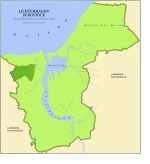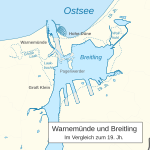German submarine U-929
1944 shipsGerman Type VIIC/41 submarinesMaritime incidents in May 1945Operation Regenbogen (U-boat)Ships built in Rostock ... and 4 more
U-boats commissioned in 1944U-boats scuttled in 1945World War II shipwrecks in the Baltic SeaWorld War II submarines of Germany

German submarine U-929 was a Type VIIC/41 U-boat of Nazi Germany's Kriegsmarine during World War II. She was ordered on 2 April 1942, and was laid down on 20 March 1943, at Neptun Werft AG, Rostock, as yard number 516. She was commissioned under the command of Oberleutnant zur See Werner Schulz on 6 September 1944.
Excerpt from the Wikipedia article German submarine U-929 (License: CC BY-SA 3.0, Authors, Images).German submarine U-929
Küstengewässer einschließlich Anteil am Festlandsockel
Geographical coordinates (GPS) Address Nearby Places Show on map
Geographical coordinates (GPS)
| Latitude | Longitude |
|---|---|
| N 54.25 ° | E 12.066666666667 ° |
Address
Küstengewässer einschließlich Anteil am Festlandsockel
18569 Küstengewässer einschließlich Anteil am Festlandsockel
Mecklenburg-Vorpommern, Germany
Open on Google Maps







